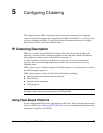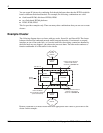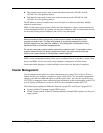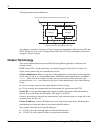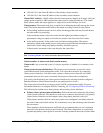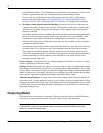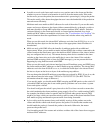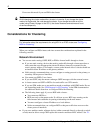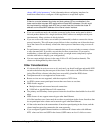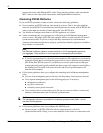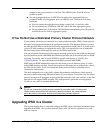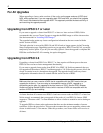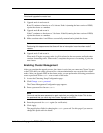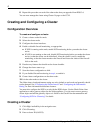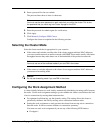
5
214 Nokia Network Voyager for IPSO 4.0 Reference Guide
Do not use this mode if you use PIM in the cluster.
Caution
Avoid changing the cluster mode while a cluster is in service. If you change the cluster
mode of a single node, the node leaves the cluster. If you change the mode on all the
nodes (using Cluster Voyager or the CCLI), the cluster dissolves and reforms and is out
of service temporarily.
Considerations for Clustering
Note
For information about the requirements for using NGX in an IPSO cluster, see “Configuring
NGX for Clustering.”
When you configure an IPSO cluster, take into account the considerations explained in the
following sections.
Network Environment
You can use static routing, OSPF, BGP, or PIM to forward traffic through a cluster.
If you use static routing, devices that need to send traffic through a cluster must have a
static route that uses the appropriate cluster IP address (internal or external) for the
route’s gateway address. For example, a router on the internal side of a cluster should use
an internal cluster IP address as the gateway address.
Nokia strongly recommends that you not configure a routing protocol on the primary or
secondary cluster protocol interfaces.
You cannot use OSPFv3 in a cluster.
If you use OSPF, only the master exchanges OSPF messages with the external routers.
A cluster cannot use OSPF or BGP to forward traffic over VPN tunnels.
If you use PIM, make sure to use multicast mode or multicast with IGMP mode. Do not
use forwarding mode. See “PIM Support for IP Clustering” in the PIM documentation
for additional details about how to configure PIM with clustering.
The following items apply if you use BGP with a cluster:
You cannot use BGP-4++.
BGP runs only on the master node. If a failover occurs, BGP stops running on the
failed master and establishes its peering relationships on the new master.
You must configure a cluster IP address as a local address.
Nokia recommends that you configure BGP so that peer traffic does not run on the
cluster protocol interfaces.
If you use a multicast mode, adjacent devices (either connected directly or through a switch
or hub) must be able to accept ARP replies that contain a multicast MAC address. See “To




